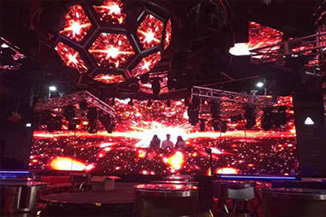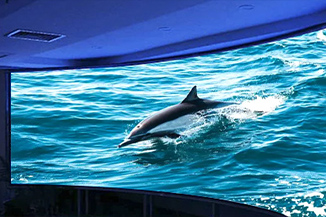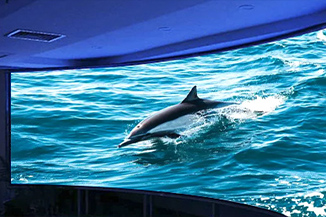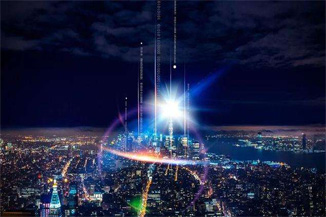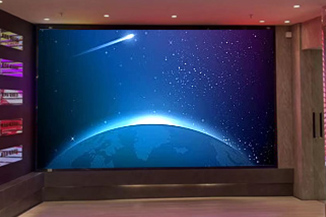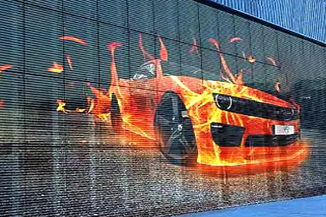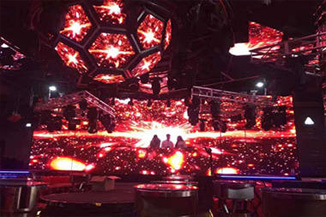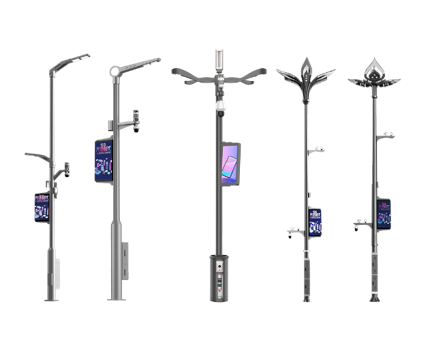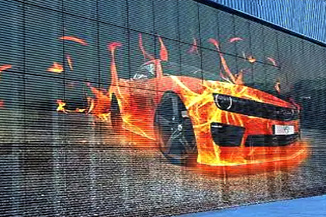Publisher: Supplier of LED Display Time: 2022-02-18 17:34 Views: 2279
Project Overview
The display installation structure frame is a lightweight steel frame, and chemical riveting bolts are used as the supporting structure in the corresponding beam and column parts. The display steel frame is connected with the riveting fixed steel plate:
The power is transmitted to the display screen power distribution cabinet by cables through the power distribution room; the display screen power distribution cabinet is installed in the screen frame, and is controlled by remote switches, PLC program controllers, air switches, AC contactors, solid state relays and other display components. etc. composition. Between the display screen and the control room, CAT5 is used as the medium for the transmission of video signals and various control signals; all external devices such as the control computer and video equipment of the display screen are installed in the control room.
The whole process includes the following links:
In-depth design and development of display screen
Manufacture of display equipment
Fabrication and installation of the metal frame in place
Layout of power and communication cables
Display and control room equipment installation
Frame aluminum plate edging decoration
System commissioning, commissioning and acceptance
Project organization
In order to make this project achieve the expected results agreed in the contract, the project organization is designed to achieve the following objectives.
Construction period objectives: According to the construction period requirements determined by the contract, fully prepare for production, technology, personnel and materials, and ensure that the installation and testing of related equipment are completed on time and delivered to the designated location.
Quality objectives: Based on the principle of contract-related technical indicators and some industry standards, formulate a detailed quality assurance plan to ensure high-quality and efficient performance of the contract.
Safety goal: formulate strict safety guarantee measures to eliminate all personal and equipment liability accidents, and ensure zero accident rate during installation and construction.
Civilized construction goals: scientific management, orderly production, unity and cooperation, multi-party cooperation, environmental protection and original facilities, clean and tidy site.
Environmental protection goals: abide by the national regulations on environmental protection to ensure that there is no pollution or damage to the on-site environment.
installment and debugging
Prepare the technical information, installation procedures, necessary technical force, instruments and special tools and equipment required for equipment installation in advance, and assign experienced installation site engineers to be responsible for technical guidance, quality supervision, on-site measurement and quality control; for installation Difficulties and temporary problems at the site, proactively negotiate with the owner and propose solutions. Focus on controlling the installation process, focusing on checking the installation accuracy of the display cabinet, to ensure that it is firm and correct, the components are complete, the installation position is accurate, the flatness and cabinet clearance meet the requirements, and the installation quality and effect are guaranteed. After the installation is completed, the screen body has no scratches and cracks, and the color is uniform. Accept the supervision, management and guidance of the owner and the supervisor, and actively take remedial measures for the supply and quality problems found during the installation process. The mechanical tools, equipment, materials and system equipment materials used for installation and construction shall be transported to the construction site in time, and the necessary performance safety inspection shall be carried out after entering the site, and a special person shall be assigned to keep them; to clean up.
System commissioning is divided into pre-factory commissioning, post-installation commissioning and system trial operation, completion acceptance test, etc. The commissioning shall follow the technical specifications of the bidding documents and the provisions of the contract, and the bidder will also respect the owner's suggestions on commissioning content and methods. After the installation of the system, the bidder shall arrange for experienced engineers and technicians to conduct self-inspection on the power distribution, system connection, structural safety, insulation, grounding, flatness and other safety and appearance quality of the system; invite the owner and supervisor to review; After the final confirmation by the project team leader, the on-site power-on debugging of the whole system will be carried out.
Installation site and safety management
1. On-site management
Organize the construction in strict accordance with the requirements of the owner on the relevant regulations of the construction site, and obey the unified management of the owner and the supervisor. To achieve a unified arrangement, unified arrangement. Do a good job in the publicity and education of civilized construction for installation and commissioning personnel, regularly check and record carefully. Do a good job of the appearance of the construction site, pull up the isolation belt and safety net at the construction site. On-site materials are reasonably stacked, neatly placed, and licensed, all kinds of materials are not stacked randomly, scattered at will, and do not pollute the surrounding environment. , timely shipment. Before starting construction, pay attention to protect other facilities around the site, set up obvious signs, and take corresponding protective measures. Protective measures should be taken for floors and walls in electrical machining, cutting, welding and other related areas. For constructions that generate a lot of noise, the work will be concentrated between 10:00 to 14:00 and 15:00 to 20:00 to ensure that the impact on the surrounding environment is minimized.
1.1 Power Construction:
Laying the power cord: The conduit must be laid when the electricity is not drawn in the same room. For outdoor wiring, the contractor shall be responsible for the construction of hidden works, such as pipe wiring and excavation restoration. During construction, other pipelines shall be avoided and the construction area shall be minimized. The wiring being laid must not be connected to the power supply. Supervised by the person in charge of installation. Power connection: first confirm that the power supply terminal is in the "disconnected" state, and must be connected from the power supply terminal (such as equipment switch or equipment distribution box, etc.). After checking that the power supply terminal is connected correctly, the power supply terminal can be connected. First, connect the protective grounding, then connect the neutral wire, and finally connect the phase wire. After the power supply is connected: Check the voltage of the power switch or the equipment distribution box, and "disconnect" the power supply after confirming that it is correct. The power cord must be
The color distinguishes the ground wire, the neutral wire and the A , B , C isophase wires. When distinguishing by color unconditionally, a fixed mark (sleeve) must be hung at the end of the line to distinguish.
1.2 Communication cable construction:
When the screen body and the control system are not in the same room, line pipes must be laid. During the construction of outdoor wiring, concealed works, and excavation restoration, other pipelines shall be avoided and the excavation area shall be minimized, and the person in charge of installation shall supervise.
1.3 Foundation construction:
Construction according to the requirements of the drawings. The foundation construction must cooperate with the pipeline construction, and the person in charge of installation shall supervise.
1.4 Steel structure construction. The construction shall be carried out according to the requirements of the drawings, and the person in charge of installation shall supervise.
1.5 Decoration and closure, edge construction. According to the drawing requirements and the material (including color) confirmed by the customer. Supervised by the person in charge of installation.
1.6 Equipment installation
1.6.1 Installation of cooling equipment: The installation of the air conditioner is the responsibility of the supplier. It is required that the installation be turned on and run for cooling immediately after the installation is powered on. The outdoor unit is stable and reliable, and the condensate discharge meets the requirements of environmental protection.
1.6.2 Cabinet installation: equipment handling. Sufficient manpower must be provided to ensure safety. Pay attention to protect the equipment, and do not damage the appearance of the equipment caused by bumping.
Preparation: Install hoisting pendants, pulleys, ropes or chain hoists with locking for lifting; the stability and reliability of the lifting mechanism must be checked before use. Prepare enough safety protective equipment, helmets, seat belts, etc. A safety helmet must be worn when entering the construction site. When working at heights, the safety belt must be fastened, and the tail rope of the safety belt must be fastened to a safe and reliable fastener.
Row-by-row positioning: Unpack the box, lift the box to the steel frame using the hoisting facility, and place it row by row according to the box number. After the box is in place, pre-tighten the box immediately to ensure the stability of the box. After adjustment, complete the tightening, and then proceed to the previous row of cabinets in place.
Adjustment: Adjust the unevenness of the light-emitting surface of the box to be less than or equal to 1mm, correct the horizontal plane of the top of the box and the vertical plane of the side, and adjust the gap between the modules of the box to be less than or equal to 1mm. Before the adjustment of each row of boxes, the horizontal line must be drawn, and the box should be adjusted according to the horizontal line, and the tightening should be completed after adjustment.
1.6.3 Installation of lighting equipment. The lighting power supply shall not be arbitrarily arranged, metal or plastic pipelines must be arranged, and the lighting arrangement shall not affect the passage, installation and maintenance operations.
1.6.4 Installation of distribution box. The installation of the distribution box must be firm and reliable. Reliable protective grounding.
1.6.5 Temporary storage of equipment must ensure safety, ensure stable placement, and prevent water, ash, falling objects and other external forces.
2. Progress management
According to the overall progress of the construction, make a specific construction schedule for each division. Strictly control the completion of all tasks on time. Reasonably arrange the construction progress and operation plan, arrange the construction force in a balanced manner, reduce the delay phenomenon caused by the connection of the procedures, and improve the construction efficiency.
3. Fire and safety management
3.1 All-round safety management in project implementation is based on prevention. Any behavior must be responsible for safety, strictly abide by various operating procedures and technical specifications, and ensure the safety of people and equipment from awareness, technology, equipment, and management. .
3.2 The project site shall be equipped with a fire safety officer who is responsible for fire prevention and safety work, and shall be equipped with fire extinguishers in accordance with relevant regulations and take fire prevention measures. Construction workers are not allowed to bring fire into the site to prevent construction workers from smoking on the site. Strictly implement the on-site fire use system, flammable materials (mainly paints and cartons) are centrally managed and stored, and clear signs are set up on the site before use, and the remaining materials after use are withdrawn from the site in time. Before using the welding equipment, submit an application to the owner and the fire prevention supervisor, and clean up the site; use a special person from the China Central Establishment to supervise; check the welding site and surrounding environment after use to ensure that there is no fire hazard.
3.3 All construction workers in the field purchase accident insurance or work injury insurance. Strengthen the security work at the construction site, especially the protection of valuable equipment and equipment, and promptly recover and properly keep valuable materials, tools and equipment. The assignment of tasks is synchronized with safety education and reminders, and the process and process handover must have safety introductions and instructions. Pay attention to the safety of electricity use. All equipment and equipment are grounded. The configuration of all temporary power transmission lines conforms to safety standards and the requirements of the owner. Protective casings are provided for cables passing through buildings, passages and other places that are susceptible to mechanical damage. Anyone has the right to point out potential safety hazards at the construction site, and the safety officer is responsible for implementing corresponding measures to eliminate hidden dangers.
3.4 Safety at height
3.4.1 It is aerial work if it leaves the ground (or floor) during operation, and 1.5 meters away from the ground (or floor) can be regarded as aerial work. 3.4.2 When using the climbing equipment, first check and ensure that the equipment is firm and stable. The climbing personnel must concentrate, and other personnel on the scene must not call the climbing personnel. The climbing personnel must not bear weight during the movement, and the moving speed should be slow when climbing. One hand and one foot are in a steady state. Climbing personnel should stop climbing operations when the outdoor weather is windy or rainy or the lighting is insufficient.
3.4.3 When working in the air, operators must use safety belts and safety helmets correctly, check the integrity of safety equipment before use, and do not use protective equipment with potential safety hazards. All items such as tools, parts, etc. shall not be placed in an unrestrained state during operation, and shall not be thrown from high altitudes.
3.4.4 The items placed on site must be stable and reliable, and the supporting objects must be fixed.
3.4.5 The installation site must be equipped with a safety officer responsible for safe construction management.
3.4.6 Repeated use of ropes, pulleys, poles, etc. must be checked for safety and reliability. When lifting objects, it is forbidden for people to stay and move below. Before lifting, check the connection between the object and the hook to ensure that it is reliable, and there should be no obstacles in the path of the object moving.
